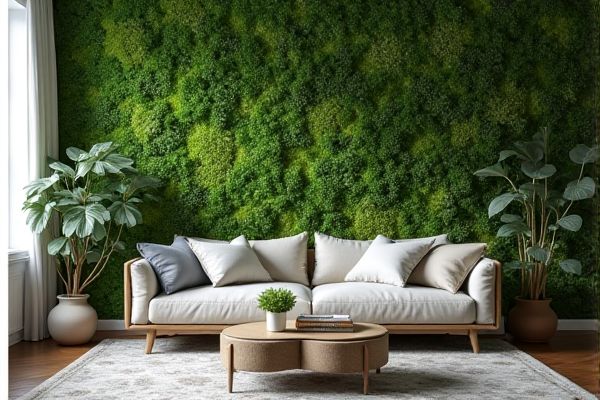
Faux ivy walls offer a realistic, low-maintenance greenery option that adds texture and elegance to your space, while moss walls bring a softer, more natural aesthetic with unique air-purifying qualities. Discover the differences that will help you decide which green wall suits your style and needs by reading the full article.
Table of Comparison
| Feature | Faux Ivy Wall | Moss Wall |
|---|---|---|
| Material | Artificial ivy leaves made of plastic or silk | Preserved natural moss |
| Maintenance | Minimal, occasional dusting | Low, no watering needed but avoid direct sunlight |
| Lifespan | Indefinite with care | 3-5 years with proper conditions |
| Appearance | Realistic green leaves resembling ivy | Soft, textured, natural green aesthetic |
| Installation | Lightweight, easy to mount on walls | Requires stable mounting; cushioning underneath recommended |
| Environmental Impact | Non-biodegradable synthetic materials | Eco-friendly, natural and biodegradable |
| Use Case | Indoor and outdoor decorative walls | Primarily indoor use due to preservation |
Introduction to Faux Ivy Walls and Moss Walls
Faux ivy walls feature realistic, synthetic ivy leaves that create a lush, green backdrop ideal for both indoor and outdoor decor, offering low maintenance and long-lasting vibrancy. Moss walls consist of preserved moss that delivers a soft, textured natural aesthetic while enhancing indoor air quality and providing sound insulation. Both options serve as versatile, eco-friendly alternatives to living walls, suited to modern interior design and commercial spaces seeking greenery without the upkeep.
Aesthetic Appeal: Faux Ivy vs Moss Walls
Faux ivy walls offer a lush, vibrant green texture that mimics natural ivy, providing a classic, elegant aesthetic ideal for both indoor and outdoor spaces. Moss walls deliver a softer, more organic appearance with rich, natural variations in color and texture, enhancing cozy, earthy environments. Choosing between faux ivy and moss walls depends on desired visual impact, maintenance preferences, and spatial ambiance goals.
Material Composition and Durability
Faux ivy walls are typically made from high-quality plastic or silk materials designed to mimic the natural appearance of ivy leaves, offering excellent durability against UV rays and moisture, making them suitable for both indoor and outdoor use. Moss walls consist of preserved or reindeer moss, which is treated to maintain its softness and natural look but requires protection from direct sunlight and excessive humidity to prevent deterioration. Your choice depends on whether you prefer the long-lasting, weather-resistant properties of faux ivy or the organic texture and sound-absorbing qualities of a moss wall.
Installation Process Comparison
Faux ivy walls typically require attaching panels or mats to a vertical surface using nails, adhesive, or hooks, making the installation straightforward and suitable for both indoor and outdoor settings. Moss walls involve preserving natural moss on a backing material that often uses adhesives or framing, requiring more delicate handling and humidity control to maintain its condition. Your choice depends on whether you prioritize ease and durability (faux ivy) or a natural, organic aesthetic with some maintenance (moss wall).
Maintenance Requirements
Faux ivy walls require minimal maintenance as they are made from synthetic materials that do not need watering, trimming, or sunlight, making them ideal for indoor and low-light areas. Moss walls, while low-maintenance in terms of watering since preserved moss does not require irrigation, may need occasional dusting and careful placement to avoid direct sunlight or high humidity that can degrade the moss. Your choice between the two should consider the specific environmental conditions and the desired upkeep level to ensure lasting aesthetic appeal.
Cost Analysis: Faux Ivy Wall vs Moss Wall
Faux ivy walls generally have a lower upfront cost compared to moss walls due to the synthetic materials used, making them a budget-friendly option for decorative greenery. While moss walls often require professional installation and ongoing maintenance to preserve their natural appearance and health, increasing their overall expense, faux ivy walls demand minimal upkeep. Your choice should factor in both initial investment and future maintenance costs to determine the most cost-effective solution for long-term aesthetic appeal.
Environmental Impact and Sustainability
Faux ivy walls, made from synthetic materials like plastic and polyester, typically have a higher environmental footprint due to non-biodegradability and energy-intensive manufacturing processes. Moss walls, often created using preserved or live moss, offer greater sustainability by utilizing natural, biodegradable components that improve indoor air quality and support biodiversity. Choosing moss walls reduces plastic waste and fosters eco-friendly interior decor with minimal environmental impact.
Indoor and Outdoor Applications
Faux ivy walls offer versatile use in indoor and outdoor spaces due to their durable, UV-resistant materials that maintain vibrant greenery year-round without maintenance. Moss walls excel indoors where humidity and temperature can be controlled, providing a natural, soft texture and air-purifying benefits but tend to degrade quickly in outdoor environments. Choosing between faux ivy and moss walls depends on the desired aesthetic, maintenance level, and environmental exposure, with faux ivy preferred for all-weather outdoor installations and moss for humidity-stabilized interior decor.
Customization and Design Flexibility
Faux ivy walls offer extensive customization options with realistic leaf shapes, varying shades of green, and the ability to incorporate flowers or decorative lights, making them ideal for versatile design themes. Moss walls provide a softer, more natural texture and color palette, often available in preserved varieties that retain a vibrant look with minimal maintenance, perfect for adding organic warmth to your space. Your choice between faux ivy and moss walls depends on the desired aesthetic complexity and adaptability for your interior or exterior design projects.
Choosing the Best Green Wall for Your Space
Selecting the best green wall for your space depends on maintenance, visual appeal, and environmental conditions. Faux ivy walls offer a versatile, low-maintenance solution with a lush, classic look ideal for both indoor and outdoor settings. Moss walls provide a natural, soft texture that thrives in low-light, humid environments, perfect for adding a calming, organic feel to interior spaces.
 homyna.com
homyna.com